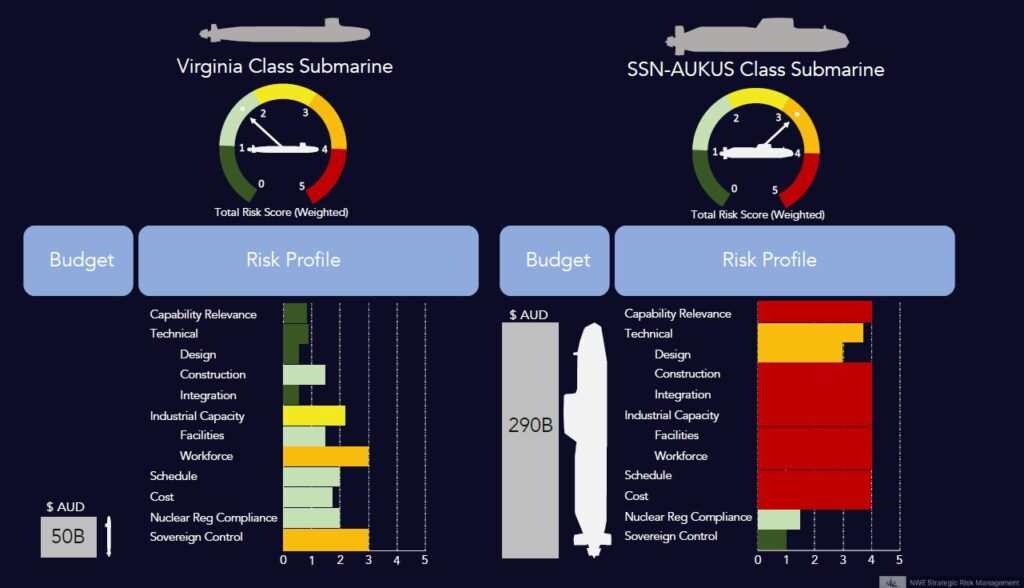
Australia should consider withdrawing from the SSN-AUKUS program to focus on expanding its fleet of Virginia Class submarines, according to a newly released risk report. The report, titled AUKUS Pillar 1 – Submarine Platform Risk Comparison, was published earlier this month by NWE Strategic Risk Management and authored by its principal, Peter Robinson.
The report provides a detailed risk analysis comparing the acquisition of Virginia Class submarines from the United States with the SSN-AUKUS nuclear-powered submarines under the AUKUS trilateral agreement. The assessment evaluated factors such as capability relevance, technical relevance, industrial capacity, schedule, cost, nuclear propulsion compliance, and sovereign control.
Robinson recommends that the Australian government mitigate sovereign control risks associated with the Virginia Class submarines through robust bilateral agreements and leverage long-standing alliance commitments, such as ANZUS. He also suggests that Australia should withdraw from the SSN-AUKUS Class program and commit long-term to the Virginia Class Block IV boats, proposing an increase in fleet size to seven or eight submarines to meet capability depth requirements. This shift could potentially save Australian taxpayers AU$233 billion.
Financial and Strategic Implications
According to Robinson, the AUKUS Pillar 1 represents the largest investment Australia has ever committed to, with a staggering AU$368 billion. He argues that this financial commitment renders the Defence Department insolvent and emphasizes the need for a clinical evaluation of cost versus risk to make objective decisions in the nation’s best interest.
“A clinical view of the cost versus risk profile is vital if we are to make objective business-case decisions in the best interest of our nation,” Robinson stated. “The risk differential is clear: SSN-AUKUS submarines are a massive gamble at a gigantic price that we should tactfully withdraw from.”
Robinson highlights that the acquisition of a small fleet of Virginia Class Block IV submarines could result in a programmatic saving of over AU$230 billion. He suggests that these savings could be redirected to bolster broader Defence capabilities through a reinvigorated Integrated Investment Program.
Challenges with the AUKUS Agreement
The report points to several challenges associated with the AUKUS agreement. Due to security restrictions, the current deal did not involve sufficient consultation for such a significant commitment of taxpayer funds. Additionally, Australia faces substantial construction risks, as it lacks experience in building nuclear submarines, and its shipyards will require significant upgrades to meet the demands of nuclear work.
Robinson also notes that UK facilities, which are part of the production chain, are already stretched and in need of significant remediation. The sole UK nuclear submarine production facilities at Barrow-in-Furness have been under-resourced for decades, which could lead to delays in technology transfer.
“The sole UK nuclear submarine production facilities have been forced to operate at the edge of their capacity, with terribly outdated infrastructure and minimal scalability,” Robinson explained.
Workforce and Regulatory Concerns
Australia’s current lack of a nuclear-qualified maritime workforce presents another challenge. Developing such a workforce domestically will take decades, even with training pipelines and international secondments. Robinson warns that any shortfall in workforce availability could create quality assurance issues, increase rework, and jeopardize the ability to sustain multiple submarines concurrently.
Furthermore, Australia will face significant cost risks through the SSN-AUKUS program due to potential design changes, inflation, exchange rate fluctuations, and material and labor costs over time. The complexity of nuclear submarines, which require compact reactors designed, constructed, operated, and disposed of under high scrutiny, adds to these challenges.
“For Australia, which currently has a tiny civilian nuclear industry and is without an existing regulatory authority for naval nuclear propulsion, this risk is magnified by the need to create a comprehensive legal and institutional framework from the ground up,” Robinson noted.
Geopolitical Considerations
Robinson also addressed global insecurity surrounding the US administration’s commitment to AUKUS, particularly under President Donald Trump. Concerns exist over the transfer of Virginia Class submarines to Australia and the potential outcomes of ongoing strategic reviews.
Despite these concerns, Robinson believes it is unlikely that the US will completely upend the essence of the AUKUS arrangement, as it generally benefits them. The financial commitment by Australia sends a clear message to China of the US intent to bolster the capability of its regional alliance partners.
“It is worth remembering that Australia is a vital link in the long-established US pivot to our region and the ability to operate nuclear-powered submarines from our continent is very appealing,” Robinson concluded.
As Australia navigates these complex decisions, the recommendations outlined in Robinson’s report could significantly influence the future direction of its defense strategy and international alliances.






